I recently went to two coffee education seminars at Starbucks stores, that were nearly back to back. One was on the 27th and the other was on the 28th. They both were fun, so I thought I’d share a little bit about them.
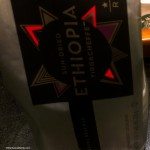 On Monday the 27th, the East Olive Way Starbucks did a coffee seminar for the Reserve Coffee, Sun Dried Ethiopia Yirgacheffe. This store is famous for regular coffee events, usually every other Monday (but you should call ahead for the schedule) at 6:00 p.m. It is open to the public, and free to attend. The seminar on Monday night was pretty amazing! 25 people showed up! I previously mentioned this amazing coffee early this month at a coffee tasting at University Village 3 Starbucks. The bottom line is that this is an amazing coffee. It just packs a ton of berry flavors, and it is wonderful by any brew method. The sun-dried Ethiopian coffee offerings are some of the most rare Starbucks offerings, so if you have the opportunity to try a bag of this, you should. The natural process method (a method of drying the coffee with the cherry on the bean, laid on tarps in the sun) is known to produce a big flavorful big cherry, or other natural berry tones to it.
On Monday the 27th, the East Olive Way Starbucks did a coffee seminar for the Reserve Coffee, Sun Dried Ethiopia Yirgacheffe. This store is famous for regular coffee events, usually every other Monday (but you should call ahead for the schedule) at 6:00 p.m. It is open to the public, and free to attend. The seminar on Monday night was pretty amazing! 25 people showed up! I previously mentioned this amazing coffee early this month at a coffee tasting at University Village 3 Starbucks. The bottom line is that this is an amazing coffee. It just packs a ton of berry flavors, and it is wonderful by any brew method. The sun-dried Ethiopian coffee offerings are some of the most rare Starbucks offerings, so if you have the opportunity to try a bag of this, you should. The natural process method (a method of drying the coffee with the cherry on the bean, laid on tarps in the sun) is known to produce a big flavorful big cherry, or other natural berry tones to it.
Coffee Masters Donna and Jess, who have conducted many of these events, walked us through tasting the coffee, and we compared it to the core Ethiopia coffee too. Take a look at the difference in the coffee beans – can you spot which of these is the core Ethiopia and which one is the Reserve Sun Dried Ethiopia Yirgacheffe?
 I always love a fantastic “smell” photo, so here’s Donna smelling the Yirgacheffe, and also you can Jess getting everything ready to go:
I always love a fantastic “smell” photo, so here’s Donna smelling the Yirgacheffe, and also you can Jess getting everything ready to go:
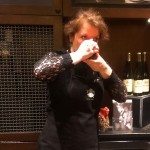
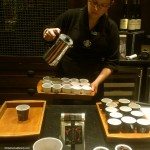 Correctly made, the French press will look oilier and have more visible sediment than the Clover-brewed Yirgacheffe:
Correctly made, the French press will look oilier and have more visible sediment than the Clover-brewed Yirgacheffe:
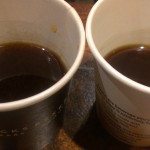 Congratulations to Donna and Jess for a fantastic tasting, and having a surprisingly large crowd.
Congratulations to Donna and Jess for a fantastic tasting, and having a surprisingly large crowd.
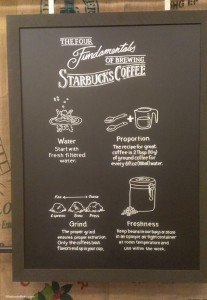 On the 28th, at the new University Village 3 Starbucks, Chad M. from the Coffee Education Department at the Starbucks headquarters, lead a seminar on the Four Fundamentals of Brewing Coffee.
On the 28th, at the new University Village 3 Starbucks, Chad M. from the Coffee Education Department at the Starbucks headquarters, lead a seminar on the Four Fundamentals of Brewing Coffee.
The four fundamentals to create a great cup of coffee are as follows:
- Water – Use only filtered water. All of the natural minerals (and possibly whatever else is in your tap water) will negatively affect the flavor of your coffee.
- Proportion – Use two tablespoons of coffee for every six fluid ounces of water.
- Grind – Make sure the grind of your coffee is appropriate for your chosen brew method.
- Freshness – Once your coffee has been ground, use it within 24 hours. Once your bag of coffee has been opened up, whether ground or not, use it within seven days. Don’t try to store you coffee in the freezer or refrigerator – this will never prolong the life of the coffee. If you bag of coffee has not been opened up yet, use before the expiration on the back of the bag.
Chad and Jen (the store manager) worked together on this event. We smelled coffee made with the correct proportion of water to grinds, comparing it to coffee made with too few grinds for the amount of water used. This was an important demonstration because sometimes customers think, “I don’t want my coffee too strong” and will use too few grinds for the amount of water. The extraction of the flavor comes out weak and wrong. It is never recommended that you do this. Here’s Chad and Jen smelling coffee:
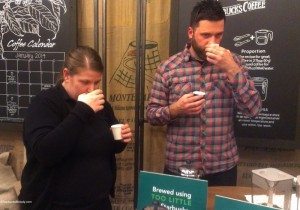 I’m getting a little ahead of myself.
I’m getting a little ahead of myself.
Water: During this coffee seminar, we drank tap water side by side with Starbucks triple-filtered water. Starbucks recommends that you use bottled water when brewing coffee at home. There’s no doubt, if you drink tap water, comparing it with Starbucks water, the Starbucks water will have a soft feel, and feel clean and gentle. I will say though, having done this same exercise before, I pretty much always walk away in awe of how good Seattle tap water is. This would be a much more dramatic demonstration at home in Southern California, where the water out of the tap is hard and awful. But no mater where you live, nicely filtered water will give you a better cup of brewed coffee.
Proportion: You should use two tablespoons of coffee for each six ounces of water. You can really see a visible difference in the coffee when you compare coffee brewed with too little grounds, with one made with the right proportions. The difference is dramatic. Coffee made with too few grounds will have little aroma, little flavor, and be weak and thin. If you want weaker coffee, brew it correctly first, and then add hot water afterwards. (Though somehow I can’t imagine wanting that).
The “Grind” portion of this coffee seminar was pretty fun. (The whole thing was fun, but I especially liked the grind demonstration!) It was like a show and tell of what household products best match the coffee grind required for certain brew methods. If you want to grind your coffee for a shot of espresso, the grind will be very fine, akin to powdered sugar. A fine grind has a texture similar to granulated sugar. Here’s what the grind set up looked like:
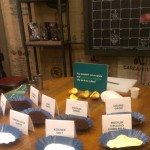
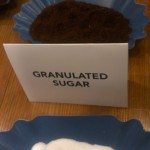 Freshness – Last but not least, once a coffee has been ground, it loses its freshness. The natural enemies of coffee are air and moisture, and once the bag has been opened it must be used within seven days. Once ground, it should be used within 24 hours. Just as once you cut an apple, it begins to brown and lose its freshness, ground coffee, once exposed to the air loses freshness quickly.
Freshness – Last but not least, once a coffee has been ground, it loses its freshness. The natural enemies of coffee are air and moisture, and once the bag has been opened it must be used within seven days. Once ground, it should be used within 24 hours. Just as once you cut an apple, it begins to brown and lose its freshness, ground coffee, once exposed to the air loses freshness quickly.
I sometimes think that one cannot go to enough coffee events. This was really fun to go two of them back to back, one of which put on my the Coffee Engagement team!
Changing the topic entirely, I have received several emails asking me about the one dollar discount for doing a store survey. Years and years ago, when you did a survey, you entered into a drawing for money – you got a chance to enter. Then the surveys changed to a free tall beverage. And then finally, they changed to one dollar off any purchase. And now, there is no reward for doing a Starbucks store survey. These surveys are still important, and your local baristas hope that you’ll fill out that you’re “highly satisfied” with your experience. I got a survey just a couple of days ago (sorry it is crumpled) so you can kind of see what they look like now:
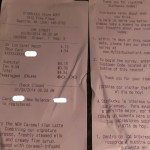 There is no incentive for doing the surveys. I hope you will still fill them out.
There is no incentive for doing the surveys. I hope you will still fill them out.
Related posts
6 Comments
Leave a Reply Cancel reply
You must be logged in to post a comment.
Sponsors
Recent Comments
- DEVIN on Compostable Straws Land in Seattle Starbucks Stores
- coffeebeanz on Why do you go to Starbucks less often? (If that’s true for you)
- Willi on You can now buy a Siren statue: $6,000
- Willi on A major revamp of your drink recipe: Testing syrup extracts and cane sugar
- Skip on Why do you go to Starbucks less often? (If that’s true for you)



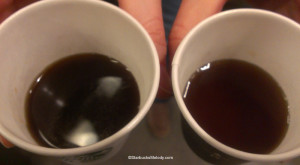



Melody two great coffee seminars! Sometimes, if I close my eyes I can feel as if I am with you at these seminars.
Re the surveys- it is a shame that SB has decided not to reward customers for completing them. I often wonder how often they are listening to the customers! BTW off topic but this am the SM at my local store told me some of the old pastries are returning effective Tuesday.
@Purple1 – I rarely mind the off topic conversation so long as it touches on Starbucks. I’ve had several people tell me things like this: Mini loaves didn’t sell, and people really want icing on their lemon loaves. Remember this:
http://www.starbucksmelody.com/2014/01/10/lemon-loaf/
Apparently they’ll keep all the La Boulange Croissants, and some of the LB items, but it looks like the pastry case kinda has slowly reverted back to pre-LaBoulange. Well, kind of.
The only thing is that apparently the mini loaves do sell in Seattle! I’m not clear if my area is going back to a lemon loaf with icing!
@Melody, thanks for another wonderful coffee seminar post. Brings back memories.
The innovation that Starbucks really needs is to get back to the good old days when every Starbucks had coffee and equipment seminars. All of what made Starbucks stand out seems to have gone away with the coffee bins and scooped coffee.
in the atlanta area were i work i have not heard of stores doing coffee seminars for a long time. my store speciffically is so busy we never even have time. its like even when we are slow weare steady.
But, but, but the Clover uses waaaaay more than 2 tablespoons per cup of coffee. 🙂
By cup, I mean 6 ounces.